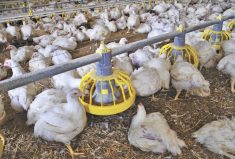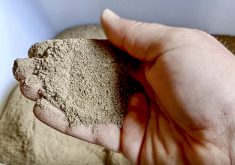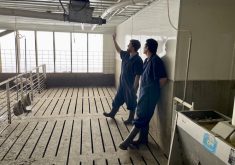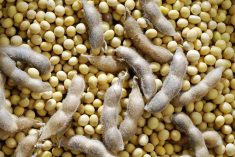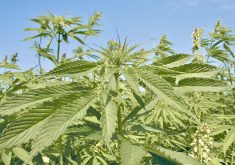Oreka Solutions Inc. could soon be selling insect protein as feed for fish and chickens in Ontario.
The Cambridge-based company got its approval by the Canadian Food Inspection Agency (CFIA) on May 14 for the sale of livestock feed for aquaculture and broiler chickens.
It has plans to ramp up production with a larger, second insect-raising barn within the next year.
Why it matters: Oreka believes its product can help increase the feed efficiency and health of animals through the use of its protein source.
Read Also

BinSentry sensors reduce feed-bin outages
BinSentry sensors mean fewer feed bin outages and more efficient deliver for feed mills.
Research trials are underway with an aim to have the feed products approved for swine and small ruminants.
The company also announced $1.8 million to fund the project, from “Toronto-based agrifood tech investment firm Umai Global, the Grober Group, a consortium of angel groups, and the Canadian government.”
In an interview with Farmtario, company founder and CEO Jon Duschinsky gave particular praise to Grober Group for using its well-established status as a leader in Ontario’s livestock feed sector to explore alternatives, and to Umai Global for taking some of its focus away from investment opportunities in the U.S. and Asia to also recognize the potential in Ontario for leading-edge agri-food innovation.
This marks the second such approval in Canada – B.C.-based Enterra was granted approval by U.S. regulators in 2016 (a North American first) and by the CFIA in 2017 – but Duschinsky offered some key reasons why Oreka’s accomplishment should be seen in a different light.
One is the diversified nature of the insect larvae production system’s nutrient-rich byproduct. Duschinsky said the cannabis industry in the southwest U.S. is already a heavy user of compost shipped across the Atlantic from insect-raising facilities in Europe. But so far, compost is the only crop-nutrient product available. The production system conceived by Oreka, by contrast, also produces a liquid soil amendment that he says should be ideal for hydroponics and other large-scale plant production systems.
The most important difference, though, Duschinsky suggests, stems from the philosophical approach taken by the Oreka Solutions leadership team. Noting that the name of the company comes from the Basque word roughly translating somewhere between “balance” and “harmony,” he says Oreka aims to take livestock feed from insects beyond the simple notion of providing an alternative source of protein, and instead re-instate insects at their rightful rung on the livestock food ladder.
“If you go back in the evolutionary diet of livestock, insects have always played a key role,” he says. “Think about it. If you put a bunch of bugs at one end of a chicken coop, and you put some chicken feed in the other end, I’m pretty sure I know which end of the coop the chickens will run to. And it won’t be the chicken feed.”
Even ruminants, he said – citing research Oreka Solutions participated in over the five years since the company was founded in 2014 – can acquire between three to five per cent of their diet from insects if they’re fed on what he sees as the animals’ natural staple of pasture.
Why is this true? Because, Duschinsky suggests, at the same time as the insects – in the case of Oreka Solutions and most other feed-from-insect producers around the world, the chosen feed source is the Black Soldier Fly larva – evolved over the millennia to withstand and thrive within harsh environments (underneath piles of rotting vegetative matter, or within the rotting carcass of a mammal), the larger animals also evolved to take advantage of the nutrient-conversion activities of the insects, by eating them.
In so doing, he says, the animals fended off disease by ingesting a hugely beneficial mixture of micronutrients, macronutrients and antimicrobials.
The Oreka production process operates on a commercial scale but still preserves the best of those disease-fighting and gut health-promoting properties in the finished insect-based livestock feed.
Another selling point for farmers considering livestock feed options, he predicts, will be the company’s zero-waste ethos. Larvae are raised using otherwise-discarded nutrient sources from the primary production, food processing and retail levels of Ontario’s agri-food industry. And the byproducts, if all goes as planned, will all be marketed as either compost or liquid soil amendments.
“We found, with the farmers we worked with, that it’s very important to them that they’re not a part of the chain anymore. With our product, they become part of the circle.”
This is not the first insect production farm in Ontario. Already, insects are raised in this province for the creation of protein-rich human food products. And Duschinsky readily admits there’s also huge potential for nutraceutical applications for insect-based additives.
But, despite what he describes as a significantly more complex pathway to CFIA approval for livestock feeds compared to foods for human consumption, Oreka’s CEO says the company aims to stay only within the livestock agriculture and aquaculture sectors.
“We want to be very focused on the market where we think there’s a need,” Duschinsky said. “What we’ve done over the past three years has only reinforced this. Some of the farmers we’ve worked with (in the trial studies) have seen incredible benefits from feeding our product. And that makes us feel like we’re on the right track.”





